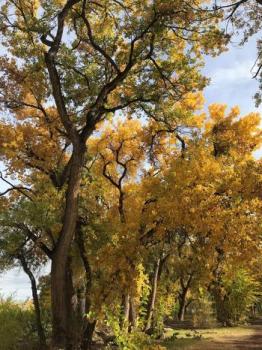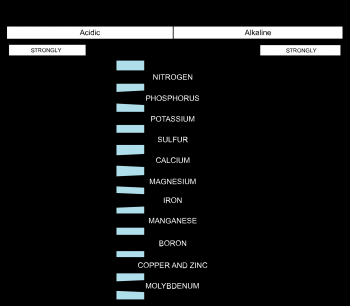November 10, 2018
Question:
I’ve seen conflicting advice online on whether or not to fertilize trees now to promote healthy root growth.
- Camille R., Albuquerque
Answer:
Don’t fertilize anything in fall because we want growth to slow with dormancy, and the salts in fertilizer will either just sit there and be unhealthy for soil/roots or actively damage roots. When carefully selected and applied, fertilizers can help boost a plant that’s already putting on a flush of top growth, like in the spring and early summer. In our areas, applying fertilizer now may extend late-season growth, and that new tender growth is particularly susceptible to cold injury.

Water, applied low and slow to the whole root zone, is the best “fertilizer” to help trees through the winter, plus a cozy, fibrous mulch layer on top of the soil. Depending on how warm this winter is in your region, how much snow we get (fingers crossed!), your soil type, the tree species, and the age of the tree, plan to water once every 3–8 weeks on warm days when the water has a chance to soak slowly down instead of forming puddles that may ice over at night.
For new trees, no fertilizer is recommended at the time of planting or in the first few years of growth. That’s mainly because we want to encourage the plant’s energy to go into root establishment, not a big bushy canopy. Remember, slow and steady wins the race.
Roots are able to produce their own growth stimulators, so no root stimulator (also called rooting hormone) is recommended at the time of planting either, or any time in the tree’s life. The applied root stimulator may do nothing and just sit there, or it may cause fertilizer burn. Where root stimulator is useful is when you’re trying to get cuttings to develop root tissues from the stem. Many plants can do this on their own, but depending on the species, the rooting powder could speed up the process before the stems start to rot.
Of course, healthy canopies promote the development of healthy roots because the carbohydrates required for plant growth are made mainly in the leaves during photosynthesis. On the other hand, healthy roots are needed to promote healthy canopies because the absorptive roots pull water and nutrients up from the soil. Many native and adapted species may never need fertilizer at all. Ideally, in most landscapes, healthy trees and shrubs will not need fertilizers because they pick up nutrients from minerals and decaying mulch and leaves in the soil.
Some nutrient deficiencies can be alleviated with specific fertilizers, but be careful not to add salts to already stressed trees. Most of our New Mexico soils have a slightly alkaline pH, which means that certain nutrients are bound in the soil, no matter how much extra you apply.

Fertilizer is not a surefire remedy. If a tree is looking sickly, applying fertilizer could be a very bad move. I like Dr. Curtis Smith’s analogy: Think of fertilizer as you think of ice cream. When you’re feeling healthy and strong, ice cream can be a nice treat. But when you’re not feeling great, health-wise, ice cream is probably not the best choice.
Fertilizer burn from too much salt build up is a common landscape problem. And nutrient toxicities can be hazardous too. Test, don’t guess! For guides on how to test your soil and where to send the samples (at-home kits can be fun and interesting, but the results are notoriously erratic), visit this week’s column online at Desert Blooms. I’ll also add a link to a column from March on pine tree fertilizer issues.
Let’s go back to the lilac flowering discussions from last week… Lilacs (Syringa vulgaris) are native to Eastern Europe and temperate Asia, but they tend to grow well in New Mexico and tolerate our mostly alkaline, saline, calcareous soils. ‘Calcareous’ means it contains calcium carbonate, aka caliche (not the custardy dessert kind of caliche cherished in southern NM). Spring application of fertilizers are often recommended to encourage more flowers, but most fertilizers come in the form of salts, which are bad news for soil health and plant roots.
Back east – not like Portales east, but more like Richmond east – it’s advised to spread wood ash from your fireplace in the garden, but they have very different soil conditions, and that practice is not recommended in the Southwest. Wood ash has high calcium content and raises soil pH, making it even more alkaline (more alkalinier?).
I asked Dr. Robert Flynn, NMSU Extension Soils Specialist, to help me explain: “Since almost all New Mexico top soils, below a certain elevation, are alkaline, it is not a good idea to add anything to the soil that is alkaline. Wood ash does contain potassium and other nutrients, but it is quite alkaline and would not help the soil. It is best to reuse the wood ash as a way to keep weeds down in the alley.”
So you can safely dispose of ashes in the trash or spread them on a driveway or someplace where you do NOT want plants to thrive.
Marisa Y. Thompson, PhD, is the Extension Horticulture Specialist, in the Department of Extension Plant Sciences at the New Mexico State University Los Lunas Agricultural Science Center, email: desertblooms@nmsu.edu, office: 505-865-7340, ext. 113.
Links:
For more gardening information, visit the NMSU Extension Horticulture page at Desert Blooms and the NMSU Horticulture Publications page.
Send gardening questions to Southwest Yard and Garden - Attn: Dr. Marisa Thompson at desertblooms@nmsu.edu, or at the Desert Blooms Facebook page.
Please copy your County Extension Agent and indicate your county of residence when you submit your question!